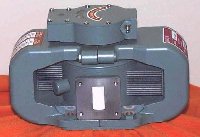- Preview
- Products
- Catalog
- Receiver Protectors
- Magnetrons
- TWT's
- CFA's
- Transmitters
- Switches
- Pressure Windows
| Magnetrons |  |
|
Agile Magnetron Design Considerations
At first glance one might conclude that the largest frequency change at the highest rate will give the best radar performance. Unfortunately, this is not a true statement.
There have been many separate theoretical studies and comprehensive experiments performed to establish the relationship between radar performance improvement and pulse-to-pulse frequency difference. An understanding of the theoretical basis for the conclusions reached in these efforts is important. In order to preserve the continuity of our discussion, we will show only the results of these studies in this section. Effective performance improvement is achieved when the frequency difference between radar pulses is large enough to eliminate any correlation between the return echoes.
Agile Excursion: The total frequency variation of the transmitter during agile operation.
Agile Rate: The number of times per second that the transmitter frequency traverses the agile excursion and returns to its starting frequency.
NOTE: There are two excursions of the frequency band for each cycle of agile rate. A plot of correlation coefficient versus pulse-to-pulse frequency difference is shown below.You will note from the figure that the minimum pulse-to-pulse frequency separation for effective decorrelation is shown to be 1/T, where T is the pulse duration.
Using this relationship, one finds that a radar operating at a 0.5 ms pulse duration will have efficient decorrelation between target echoes if pulses differ in frequency by at least 2 Mhz. Note that the required frequency separation is a function only of the pulse duration.
According to the plot of the figure, as frequency separation increases above the value 1/T, pulse decorrelation continues to improve, however, the amount of improvement is negligibly small for large increases in pulse frequency separation. In practical situations, the improvement in decorrelation obtained by increasing the frequency separation to values greater than 1/T is usually more than offset by other factors. For example, as pulse-to-pulse frequency difference increases, the receiver circuitry needed to assure stable LO (Local Oscillator) tracking also increases, in both complexity and physical size.The accuracy necessary for LO tracking relates directly to the IF bandwidth needed to pass the resultant video signal. Any increase in IF bandwidth, needed to offset inaccuracies in LO tracking, will reduce overall receiver sensitivity and tend to defeat the original purpose. Experience has shown that if one designs for pulse-to-pulse frequency separation as near as possible to, but not le ss than, 1 /T (where T is the shortest pulse duration used in the radar) optimum system performance will be achieved.Experimental studies have shown that performance improvement varies as N, where N is the number of independent (decorrelated) pulses integrated within the receiver circuitry, up to a maximum of 20 pulses.
It should be noted that the number of pulses, which can be effectively integrated, cannot be greater than the number of pulses placed on the target during one scan of the antenna and, therefore, the antenna beamwidth and scan rate become factors which must also be considered in determining the integration period of the radar.
Using the above, a design value for Agile Excursion can now be expressed in terms of radar operating parameters.
Agile Excursion = N/T
Where N is the number of pulses placed on the target during one radar scan, or 20 whichever is smaller, and T is the shortest pulse duration used in the system.
Determination of the required agile rate is now required. The object is to traverse the full agile excursion range in the time needed to transmit the number of pulses on the target during one antenna scan.
Example:
- Assume one desires to add agility to a radar having the following operating parameters:
- Pulse Duration 0.25, 0.5 & 1.0 ms
- Duty Ratio 0.001
- Pulses on Target, per scan 16
- Duty Ratio 0.001
- Using the formulas derived above one obtains:
- Agile Excursion = N/T = 16/0.25 = 64 MHz
- (pulse-to-pulse frequency separation
- = 1/T = 1/0.25 = 4 MHz
- R = duty/T = 0.001/0.25 x 10-6 = 4000 pps
- Time for 16 pulses = 16/4000 = 0.004 s
- Agile Rate* = 1/(2)(0.004) = 125 Hz
- (pulse-to-pulse frequency separation
* The 2 in the denominator accounts for the fact that two excursions through the agile frequency range occur during each cycle of agile rate.
The agile parameters used above were derived using clutter reduction as the prime objective. Elimination of target scintillation requires the satisfaction of one additional constraint, namely that the agile excursion in Mhz should be at least equal to 150/D, where D is the characteristic distance, in meters, between major reflecting points on the target cross section. For most practical situations, an excursion which satisfied the requirements of clutter reduction will usually be sufficient to satisfy the requirements of target scintillation also.
Further information and data on agile coaxial magnetrons can be obtained by requesting the Frequency Agile Magnetron Story booklet.